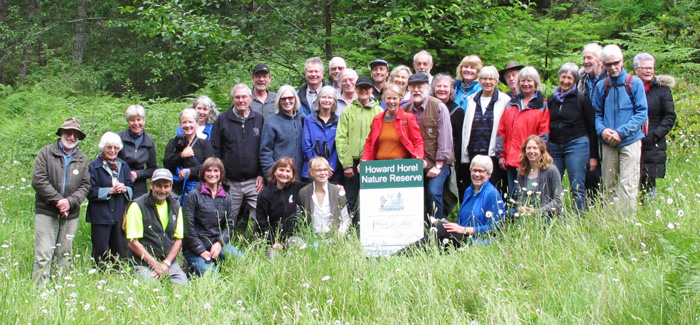An island institution that began as the dream of seven local women has now enjoyed a quarter century in action as a successful and highly regarded body for land conservation.
Nancy Braithwaite, Fiona Flook, Heather Martin, Maureen Milburn, Ailsa Pearse, Mallory Pred and Ann Richardson deserve thanks for their vision. It’s been 25 years since the Salt Spring Conservancy held its first annual general meeting, and five years have passed since the nonprofit organization moved to a new home base at the Blackburn Lake Nature Reserve. Although pandemic realities curtailed any anniversary events for this year, there is still plenty to celebrate. At the same time, the value of the conservancy’s work has only become more apparent.
“I think COVID is really showing us how important nature is for us,” said Susan Hannon, president of the conservancy’s board of directors. “We’ve certainly noticed a lot more people coming to our reserves. And hits on our website have really gone up, so people are really, really connecting to nature right now. I personally find being in nature quite healing.”
The conservancy has helped protect some of Salt Spring’s most important natural assets through community fundraising campaigns and local government partnerships. It started early on with the Mill Farm and went on to include areas of Mount Maxwell, Mount Erskine, Mount Tuam and Burgoyne Bay. Lands donated directly to the organization’s care meanwhile became the Andreas Vogt, Alvin Indridson, North View, Howard Horel, and Robert and Shauna Makaroff nature reserves. Other land donations allowed the Blackburn Lake reserve to expand.
As the conservancy reported in a recent edition of its newsletter, today it “stewards eight nature reserves and holds 17 conservation covenants, together totalling 1,554 acres, works with landowners through voluntary stewardship agreements to protect an additional 814 acres of privately owned property, and supports the protection of additional ecologically valuable lands in collaboration with partners.”
Having such an active body with obvious results is one reason the conservancy has attracted strong community membership over the years, along with consistently impressive board members.
Hannon had heard of their work even before she moved to British Columbia from Alberta. After retiring as a university professor in ecology and conservation biology, she chose Salt Spring as her new home because it still had a lot of forest cover and protected areas compared to other Gulf Islands. She was approached by conservancy members about joining the board soon after she arrived, and gladly joined their effort.
“For me, I felt hands-on conservation was really going to make a difference and leave a legacy in terms of preserving biodiversity,” Hannon said.
The conservancy is continuing that legacy through its own land holdings, helping others to register protective covenants and by providing land stewardship education.
The organization is not focused on acquiring more land itself, although Hannon said it will most likely increase its holdings if the right circumstances arise. Protecting watersheds and large blocks of forest will be a priority for new acquisitions.
“Having continuous habitat is very important for biodiversity. Little blocks become less and less resilient and can’t hold as many species,” Hannon explained.
The conservancy will also prioritize special habitats within the Costal Douglas-fir ecosystems such as Garry oak meadows, and wetlands.
“They hold a lot of biodiversity in our landscape and are important for water retention,” Hannon said. “I think the other byproduct of protecting land is creating a large carbon sink that will be protected in perpetuity. By protecting trees we will be sequestering carbon, which can only be good.”
The conservancy has been working hard at restoring natural landscapes and ecosystems within the eight nature reserves it now owns. That includes work at its two most recent acquisitions: planting trees and shrubs at the Howard Horel Nature Reserve and restoring wetlands and replanting the uplands at the Blackburn Lake Nature Reserve.
Since 75 per cent of the island is privately owned, education around how to protect native plant and animal species is another significant aspect. Maintaining and evolving the long-running Stewards in Training Program (currently on hold due to the pandemic) for all island school children from kindergarten through Grade 8 is a way to start that education and appreciation for nature early.
Creating stewardship agreements with landowners can build on that relationship with nature in a lasting way. Property owners sign these documents as an indication of good faith that they will try to protect their properties’ natural ecosystems through things like removing invasive species, incorporating native and drought tolerant plants into landscaping and eliminating pesticides. Conservancy staff do site visits to advise on the best course. There are now 69 active agreements on the island.
Additional ongoing work by the conservancy includes monitoring species at risk and providing habitat for them. One example is providing nesting boxes for western screech owls in its nature reserves and sometimes on private lands.
Even with significant island support and success with granting agencies, the conservancy has faced challenges that affect programming. Staffing has been reduced in recent years as one result of funding reduction.
“A shift in priorities for some of our historic grantors has meant that raising core operating funds locally is more important than ever. Most grants are targeted to special projects and do not cover operating costs or overhead and only cover a portion of staff salaries,” Hannon explained.
A fall fundraising campaign is now underway. Donations can be made through the website.

